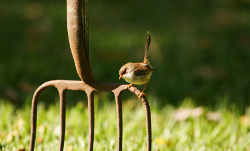ARC Centre of Excellence in
Vision Science

In a major advance in understanding how our
eyesight works, Australian scientists have shown that birds? amazing
flight and landing precision relies on their ability to detect edges.
The research suggests that edge detection is crucial in helping all
animals, including humans, move around safely, and may be more important
than our ability to see colour.
The study by the Vision Centre and University of Queensland found that
budgerigars ignore colour and look for the edge of an object in order to
ensure a smooth landing, and will be published in PLoS ONE on 7
October.
Although a lot is known about the visual cues that help birds navigate
when flying over long distances, this is the first study to reveal how
budgies navigate from moment to moment and choose where they land, said
Partha Bhagavatula, who completed the research as part of his PhD.
?It makes sense that birds use contrasting edges to target their
landing ‐ the edge of an object normally presents a good place to get a
strong grip and it can help birds to avoid over or undershooting,? said
Bhagavatula.
The findings have helped scientists understand how birds fly and land
so accurately, particularly in dense spaces and low light, and also
provide insight into human vision.
?Our results reflect studies on edge detection in bees and primates and
suggest that edge detection is critical to helping all animals, including
humans, move around. Colour vision is important when it comes to
recognising objects, but these findings suggest you don?t need it in order
to do many day to day tasks,? said Dr Mandyam Srinivasan, Bhagavatula?s
co‐supervisor from the Queensland Brian Institute.
The findings also suggest that edge detection may be the key to
creating unmanned aerial vehicles (UAVs) and flying robots that can dodge
objects while travelling through cluttered environments, a feature that is
in high demand, according to Dr Srinivasan.
In order to test the visual features that guide budgies landing,
Bhagavatula and a team placed a feeder tray in the middle of a disc on a
background of blue paper.
Even though the food was in the centre of the disc, the birds landed on
the edge and then walked to the middle. ?This showed that they were using
the contrasting edge of the disc to guide a safe landing, instead of just
setting down close to the food,? said Bhagavatula.
Different coloured discs were used under the same conditions, and
although the budgies had the ability to differentiate between all of the
colours and the background, there were certain shades that they appeared
to be unable to find the edge of. When these discs were used, the budgies
landed anywhere.
?Birds can see in all three of the human primary colours ? red, blue
and green ? and also ultraviolet, but their edge detection skills appear
to be colour‐blind,? said Bhagavatula.
This suggests that the ability to detect edges may have evolved before
colour vision in birds and may be more useful for navigating in their
environment, he added.
?When birds are flying through dense foliage they may not be able to
see much colour, as it is often in the low light of dawn or in the dark,
but the contrast between edges is a fairly constant marker. It may be more
practical for them to manoeuvre this way.?
The fact that animals that are so different, like birds, bees and
humans, all use edge detection to help them navigate in cluttered
environments shows just how crucial this aspect of vision is, according to
Dr Charles Claudianos, a co‐supervisor from the Queensland Brain
Institute.
?It is great to take information we have learned from insect studies
and applied it to studies of vertebrates. It is remarkable how the
evolution of such different creatures leads to very similar mechanisms,?
said Dr Michael Ibbotson, a co‐supervisor from the Vision Centre at
Australian National University.
The study in birds could also help scientists understand exactly how
the human eye detects edges, he added.
?We are finding more and more that things we discover in bees and birds
are also true in humans.
We know a lot more about nerve cells in certain animals than we do in
human ones, so we can work out how they detect edges and then apply it to
humans.?
The findings will also help to build flying robots and UAVs that can
fly quickly in dense environments, said Dr Srinivasan.
?Birds are very agile, especially when flying through cluttered
environments, and edge detection plays an important role in their
manoeuvring. We can use this knowledge to create UAVs capable of dodging
skyscrapers and flying in busy CBDs, which is something people are
particularly interested in at the moment.?
The paper, Edge Detection in Landing Budgerigars (Melopsittacus
undulatus), by Partha Bhagavatula, Charles Claudianos, Michael
Ibbotson and Mandyam Srinivasan will be published in PLoS ONE on
Wednesday 7 October at 10am AEST.
http://www.sciencealert.com.au/news/20090810-19951.html# | 
